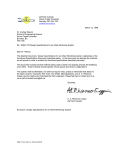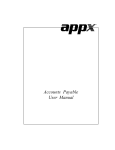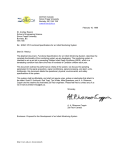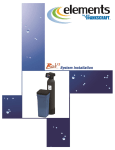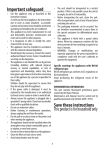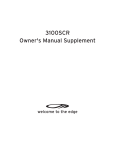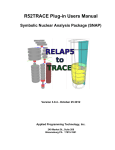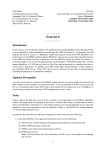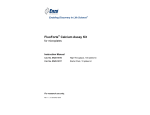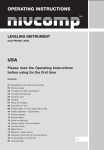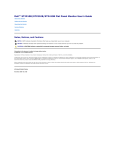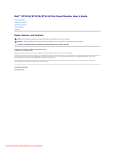Download Beyond the Horizon - School of Engineering Science
Transcript
Beyond the Horizon School of Engineering Science Burnaby, BC V5A 1S6 [email protected] http://www.staircraft.org October 16, 2000 Dr. Andrew Rawicz School of Engineering Science Simon Fraser University Burnaby, British Columbia V5A 1S6 Re: ENSC 340 Functional Specification for StairCraft – a Stair-Climbing Mechanism Dear Dr. Rawicz: The attached document, StairCraft Functional Specification, outlines the functional requirements for our project for ENSC 340 (Engineering Science Project). Our goal is to design and implement a stair traveling device that can carry heavy loads and can be applied to wheelchairs or cargo loading devices to move up and down stairs smoothly and reliably. The attached document lists the functional requirements of the system as well as the specifications for the components of the system. The system components include the mechanical structure and framework, user interface, signal acquisition unit, input/output signal conditioning unit, micro-controller, and actuator unit. Beyond the Horizon consists of six talented, innovative and enthusiastic fourth-year systems engineering students – Wayne Chen, Kenneth Cheng, Jeff Hsu, Andy Ma, Michael Tam, and Gordon Yip. If you have any questions or concerns about our document, please feel free to contact any of us by emails at [email protected] or contact me by phone at (604) 9266600 or by e-mails at [email protected] Sincerely, Kenneth Cheng Team Manager Beyond the Horizon Enclosure: Functional Specification for StairCraft – a Stair-Climbing Mechanism Beyond the Horizon presents a Stair-Climbing Mechanism Functional Specification Prepared by: Kenneth Cheng Wayne Chen Jeff Hsu Andy Ma Michael Tam Gordon Yip Contact e-mail: [email protected] Submitted to: Steve Whitmore Andrew Rawicz Jason Rothe James Balfour Date: October 16, 2000 http://www.staircraft.org Beyond the Horizon Functional Specification Executive Summary Everyone should share equal rights, even physically challenged people. However, due to their physical constraints, it may be very difficult for them to go to wherever they want. The invention of wheelchairs improves the mobility of injured, handicapped, or elderly people. Nevertheless, wheelchairs have their limitations, including traveling staircases and steps. Therefore, our objective is to develop a new mechanism allowing wheelchairs to bypass the stairs and travel Beyond The Horizon. Many assistive devices have been invented to help physically disabled people. These people are confronted with many challenges that result from their disabilities, and mobility is the most significant challenge they have to face. Assistive devices such as wheelchairs and prosthetics are developed to improve mobility. In terms of mobility, the invention of wheelchairs allows injured, handicapped, or elderly people with declined mobility or permanent disability to increase their mobility with the use of wheelchairs. Unfortunately, as the wheelchair users encounter situations such as staircases or higher/lower steps while traveling, they often need to find elevators or ramps in order to arrive at their destination levels. In some situations, where elevators and ramps are not available or too far away, it is more convenient to have wheelchairs capable of bypassing the heights. At Beyond The Horizon, we feel that there is a real need to improve and add a stair-climbing feature to the current wheelchair design, especially as the baby boomers are getting old. Our short-term goal in the coming few months is to create a bare-bone device or mechanism (StairCraft) that is capable of climbing up/down stairs and carrying cargos. Eventually, we will further develop StairCraft to be integrated into wheelchairs so that it can help people on wheelchairs to go to places where they would have trouble reaching in the past. This document introduces and discusses the main functional blocks of the electrical requirements as well as the physical, mechanical, environmental, and safety performance specifications of the system. Copyright 2000 ii http://www.staircraft.org Beyond the Horizon Functional Specification Table of Contents EXECUTIVE SUMMARY ................................................................................................II 1 INTRODUCTION .......................................................................................................1 2 SYSTEM OVERVIEW ............................................................................................... 2 3 ENVIRONMENT REQUIREMENTS........................................................................ 3 4 PHYSICAL REQUIREMENTS.................................................................................. 3 5 USER INTERFACE .................................................................................................... 4 6 SENSORY INPUT, PROCESSOR, AND ACTUATOR OUTPUT ........................... 5 6.1 SIGNAL ACQUISITION .............................................................................................. 6 6.2 INPUT SIGNAL CONDITIONING ................................................................................. 7 6.3 SIGNAL PROCESSING ............................................................................................... 8 6.4 OUTPUT SIGNAL ENCODING .................................................................................... 9 6.5 ACTUATOR INTERFACE ......................................................................................... 10 7 ELECTRICAL REQUIREMENTS .......................................................................... 11 8 SAFETY REQUIREMENTS .................................................................................... 11 8.1 OVERALL MECHANICAL STRUCTURE ..................................................................... 11 8.2 ELECTRICAL ISOLATION ........................................................................................ 11 9 RELIABILITY REQUIREMENTS.......................................................................... 12 9.1 ACCURACY ........................................................................................................... 12 9.2 STABILITY ............................................................................................................ 13 9.3 DURABILITY ......................................................................................................... 13 10 STANDARDS......................................................................................................... 14 11 TESTING METHOD............................................................................................. 14 11.1 SENSORY COMPONENT TESTING ............................................................................ 14 11.2 PROCESSING COMPONENT TESTING ....................................................................... 14 Copyright 2000 iii http://www.staircraft.org Beyond the Horizon Functional Specification 11.3 ACTUATOR COMPONENT TESTING ......................................................................... 15 11.4 MECHANICAL COMPONENT TESTING ..................................................................... 15 12 TRAINING............................................................................................................. 15 13 USER MENU ......................................................................................................... 15 14 COMPATIBILITY WITH OTHER SYSTEMS................................................... 16 15 POTENTIAL SYSTEM LIMITATION ............................................................... 16 16 CONCLUSION ...................................................................................................... 16 Copyright 2000 iv http://www.staircraft.org Beyond the Horizon Functional Specification List of Figures FIGURE 1: SYSTEM OVERVIEW................................................................................................2 FIGURE 2: DATA FLOW BLOCK DIAGRAM OF STAIRCRAFT ...................................................... 2 FIGURE 3: SIGNAL PROCESSING FROM THE INPUT SENSORS TO THE OUTPUT ACTUATORS .........5 FIGURE 4: STAIRCRAFT SIGNAL PROCESSING – SIGNAL ACQUISITION...................................... 6 FIGURE 5: BLOCK DIAGRAM FOR THE SIGNAL ACQUISITION STAGE .........................................6 FIGURE 6: STAIRCRAFT SIGNAL PROCESSING – INPUT SIGNAL CONDITIONING .........................7 FIGURE 7: BLOCK DIAGRAM FOR THE INPUT SIGNAL CONDITIONING STAGE ............................ 7 FIGURE 8: STAIRCRAFT SIGNAL PROCESSING – SIGNAL PROCESSING .......................................8 FIGURE 9: BLOCK DIAGRAM FOR THE SIGNAL PROCESSING STAGE .......................................... 8 FIGURE 10: STAIRCRAFT SIGNAL PROCESSING – OUTPUT SIGNAL ENCODING .......................... 9 FIGURE 11: BLOCK DIAGRAM FOR THE OUTPUT SIGNAL ENCODING STAGE .............................. 9 FIGURE 12: STAIRCRAFT SIGNAL PROCESSING – ACTUATOR INTERFACE ............................... 10 FIGURE 13: STABILITY REQUIREMENTS OF STAIRCRAFT ........................................................ 13 List of Tables TABLE 1: STAIRCRAFT ENVIRONMENT REQUIREMENTS ........................................................... 3 TABLE 2: STAIRCRAFT PHYSICAL REQUIREMENTS .................................................................. 3 TABLE 3: PHYSICAL REQUIREMENTS OF STAIRS FOR TRAVELING ............................................ 3 TABLE 4: HIGHLIGHTS OF REQUIRED PHYSICAL ACCESSORIES ................................................. 4 TABLE 5: SUMMARY OF THE ELECTRICAL REQUIREMENTS OF STAIRCRAFT............................ 11 TABLE 6: SUMMARY OF THE COMPONENT ACCURACY OF STAIRCRAFT .................................. 12 Copyright 2000 v http://www.staircraft.org Beyond the Horizon Functional Specification 1 1 Introduction Injured, handicapped and elderly people traveling with their wheelchairs all face a common problem – they cannot go to their desired destinations as convenient as the rest of the population. Not all buildings provide ramps, elevators, escalators, or other assistive devices that transport wheelchairs to higher or lower altitudes. In addition, lifting heavy objects up and down stairs has resulted in numerous injuries. Thus, Beyond the Horizon aims to address all these problems by creating a device that can travel along staircases smoothly, reliably and most importantly – safely. We are dedicated to create StairCraft that brings enhanced mobility to wheelchairs in such a way that stairs or steps are no longer obstacles for the wheelchairs. Injured, handicapped, and elderly people retain their freedom to travel on routes that they have once tried to avoid. Our proposed device can also be applied to and combined with cargo transporters as well as other machines, such as robots, that may desire to travel up and down the stairs automatically. The purpose of this document is to describe the environmental, physical, electrical, safety, and other functional requirements that we intend to incorporate into our system by December 2000. The design engineers of Beyond the Horizon prepare this document for internal reference and for external distribution to Andrew Rawicz, Steve Whitmore, Jason Rothe, James Balfour, and other external design consultants. Copyright 2000 http://www.staircraft.org Beyond the Horizon Functional Specification 2 2 System Overview The StairCraft stair traveler transports users or other goods up/down stairs. Based on user inputs and statuses of the sensors, the central processing unit analyzes the input signals and StairCraft reacts by driving its motors. Figure 1 illustrates the relationship between the users, StarCraft, and the stairs. User User Command, Cart Motion Distance to Stair Steps Stairs StairCraft™ Stair Traveler Sensors CPU, Motors Figure 1: System Overview Figure 2 illustrates the block diagram of how input data is processed through each component within StairCraft. Data Acquisition Sensor data Wheel-driving Motors Lifting Motors User Input !" Cart Direction !" Platform Level CPU Steering System !" Start/Stop !" Power Braking System Figure 2: Data Flow Block Diagram of StairCraft Copyright 2000 http://www.staircraft.org Beyond the Horizon Functional Specification 3 3 Environment Requirements StairCraft shall meet the following environmental requirements listed in Table 1. Table 1: StairCraft Environment Requirements Operating Temperature Storage Temperature Humidity Heat Dissipation Altitude -20°°C ~ 60°°C -20°°C ~ 70°°C Full range of ATM humidity Minimal Maximum 6000m above sea level 4 Physical Requirements The overall enclosure of the prototype shall approximately match the dimension of an existing wheelchair, which is about the space spanned by the user with a sitting posture. The prototype shall be rigid and stable statically and dynamically. The physical requirements of StairCraft are highlighted in Table 2. Table 2: StairCraft Physical Requirements Height Length Width Weight Traveling Speed Load Capacity 10 inches minimum (normal traveling mode) 3½ ft maximum (when fully extended) 3 ft maximum 2 ft maximum Less than 100 lbs 0 to ~30 cm/s 200 lbs minimum StairCraft is designed to bypass standard staircases without any obscure surfaces. The physical requirements of stairs are shown in Table 3. Table 3: Physical Requirements of Stairs For Traveling Type of Stairs Height Depth Width Copyright 2000 Standardized, solid, straight and even edged 4 inches to 6 inches 9 inches minimum 2½ ft minimum http://www.staircraft.org Beyond the Horizon Functional Specification 4 StairCraft requires an elegant mechanical solution to travel up/down stairs smoothly. Table 4 lists the accessories that are required to implement the proposed stair-climbing mechanism. Table 4: Highlights of Required Physical Accessories Type of Accessories Casters Motors Modified Car Jacks Platform Seat Number of Parts 8 minimum 9 minimum 4 minimum 1 0–1 5 User Interface The user interface of StairCraft will be a wired control pad of the size that can be held by the user with one hand and operate the control buttons with another. The controls on the control pad shall consist of: !" A power on/off switch. !" A large emergency stop button. !" Four buttons for forward, backward, left, and right motions. !" Three buttons for controlling normal, upstairs, and downstairs modes. !" Two LED’s indicating if the system is going up or down. !" An error-indicating LED. !" A simple LED display showing battery status. Copyright 2000 http://www.staircraft.org Beyond the Horizon Functional Specification 5 6 Sensory Input, Processor, and Actuator Output StairCraft will make use of a sensory input system to detect the presence of the staircase steps being approached. After the sensors receive signals indicating that a stair step is encountered, the input signals will be buffered and conditioned. Signal conditioning includes all the filtering, amplifying, rectifying, and analog to digital converting sub-processes, and these are necessary for the micro-controller to understand the input signals. After signal conditioning, the microprocessor reads the sampled inputs, determines how far away the step is and how long StairCraft will reach the step, and then decides on the motor action. The processor commands will go through another signal encoding stage to convert these commands to something the motors and other actuators understand. Finally, the actuators react based on the processor commands. Figure 3 illustrates how StairCraft processes the signals from the input sensors to the output actuators. Sensor Signals Signal Acquisition Input Signal Conditioning Signal Processing Actuator Actions Actuator Interface Output Signal Encoding Figure 3: Signal Processing from the Input Sensors to the Output Actuators Copyright 2000 http://www.staircraft.org Beyond the Horizon 6.1 Functional Specification 6 Signal Acquisition In this stage, StairCraft makes use of a proximity sensor to capture the input data. Figure 4 illustrates the context diagram with the signal acquisition stage highlighted. Signal Acquisition Input Signal Conditioning Signal Processing Output Signal Encoding Actuator Interface Figure 4: StairCraft Signal Processing – Signal Acquisition Since StarCraft needs to be able to “see” the staircase well before it hits it, the sensors of StairCraft shall have a superior sensing range. In addition, because StairCraft may be operated under various temperature and humidity conditions, the sensors shall be able to work under these conditions as well. Overall, the sensors shall meet the following specifications: • • • • • • • • • Sensing Range: up to 1 feet (30.5cm) Operating Temperature: -20°C ~ 50°C Operating Humidity: up to 10% ~ 100% Operating Frequency: 10kHz ~ 40kHz Supply Voltage: 10V ~ 20V Supply Current: up to 30mA Response Time: 0.8ms ON, 0.8ms OFF Resolution: ±0.5% Full Scale (minimum) Sensitivity: 0.05 ~ 0.15mV/V/0.001inch at outer sensing range 0.8 ~ 1.0 feet However, in our project, the sensing targets must meet the following criteria for the sensors to operate properly: • • • Angle of impact for the sensor signal: 90°, with ±1% of tolerance The sensor target shall have a smooth surface (so the signal will not be deflected) The steps of the staircase must have solid vertical front walls Figure 5 illustrates the block diagram for the signal acquisition stage. Signal From Stair Steps (Impulse) Switch / Sensor To Input Signal Conditioning Figure 5: Block Diagram for the Signal Acquisition Stage Copyright 2000 http://www.staircraft.org Beyond the Horizon 6.2 Functional Specification 7 Input Signal Conditioning After the input signal is acquired, the signal will go through the input signal conditioning stage. Figure 6 illustrates the context diagram with the input signal conditioning stage highlighted. Signal Acquisition Input Signal Conditioning Signal Processing Output Signal Encoding Actuator Interface Figure 6: StairCraft Signal Processing – Input Signal Conditioning Within the input signal conditioning stage, there are sub-building blocks to convert the raw input data to something the microprocessor can understand. The input signal conditioning stage shall have the following functionalities: • • • Filter out the noise from the input signal. Amplify/Rectify the input signal. Perform analog to digital conversion. Figure 7 illustrates the block diagram for the input signal conditioning stage. Signal From Signal Acquisition Amplification / Filter Stage A/D Stage To Signal Processing Figure 7: Block Diagram for the Input Signal Conditioning Stage Copyright 2000 http://www.staircraft.org Beyond the Horizon 6.3 Functional Specification 8 Signal Processing A microprocessor is used in the signal processing stage. Figure 8 illustrates the context diagram with the signal processing stage highlighted. Signal Acquisition Input Signal Conditioning Signal Processing Output Signal Encoding Actuator Interface Figure 8: StairCraft Signal Processing – Signal Processing The microprocessor shall perform the following duties: • • • • • • Based on the strength of the input signal, calculate the distance to the stair step encountered. Keep track of the current status of StairCraft. Deduce the current position on the staircase in order to decide on which motor to turn. Process the user commands sent from the user interface. Command all wheel driving, steering, and braking actuators (motors, solenoids, etc). The microprocessor must be able to operate under the same condition as the sensors (specified in section 6.1). Figure 9 illustrates the block diagram for the signal processing stage. Signal From Input Signal Conditioning Signal Analysis Output Generation To Output Signal Encoding Figure 9: Block Diagram for the Signal Processing Stage Copyright 2000 http://www.staircraft.org Beyond the Horizon 6.4 Functional Specification 9 Output Signal Encoding The commands sent by the microprocessor need to be further processed so that they can be used as signals to enable the actuators. Figure 10 illustrates the context diagram with the output signal encoding stage highlighted. Signal Acquisition Input Signal Conditioning Signal Processing Actuator Interface Output Signal Encoding Figure 10: StairCraft Signal Processing – Output Signal Encoding The output signal encoding stage shall contain the following features: • • Perform digital (or any logic) encoding to convert microprocessor output commands to digital input signal for the actuators. Perform digital to analog conversion for the actuator input signals. Figure 11 shows the block diagram for the output signal encoding stage. Signal From Signal Processing Signal Encoding D/A Stage To Actuator Interface Figure 11: Block Diagram for the Output Signal Encoding Stage Copyright 2000 http://www.staircraft.org Beyond the Horizon 6.5 Functional Specification 10 Actuator Interface Figure 12 illustrates the context diagram with the actuator interface stage highlighted. Signal Acquisition Input Signal Conditionin g Signal Processing Output Signal Encoding Actuator Interface Figure 12: StairCraft Signal Processing – Actuator Interface As shown in Figure 12, this is the final destination of the whole signal processing process. The actuator interface contains all the wiring connections to all the actuators (motors and solenoids). The actuators react based on the commands sent by the microprocessor. The followings are the functional requirements of all actuators used in StairCraft: • • • • • • • • (Steering) The left and right wheel-drive motors must be able to operate individually (one ON the other OFF) so that steering left or right can be accomplished. (Steering) All wheel-drive motors must be able to rotate both in clockwise and counter-clockwise directions so that forward or backward motions can be accomplished (Braking) Each of the active wheels (the ones driven by motors) must have a braking mechanism, which provides enough friction and is able to stop the cart within 0.5 second. (Wheel-Drive) The wheel-drive motors will be located at the front set of wheels. (Wheel-Drive) Each of the wheel-drive motors shall be able to sustain 120 ~ 150lb of load (200lb ÷ 2 sets of wheels at one time = 100lb, adding 20% ~ 50% contingency factor ⇒ 120lb ~ 150lb) (Wheel-Drive) Each of the wheel-drive motors (after gear ratios are taken into account) shall have a rotational speed of 30 ~ 60 rpm (for wheels of 4 inches in diameter, the linear velocity turns out to be: (4×2.54cm) π (30 ~ 60) / 60sec = 16 ~ 32 cm/sec). (Lifting) Each of the platform lifting motors shall supply 30 ~ 40 lb•inch of torque for a shaft diameter of about 0.50 inch (120 ~ 150lb × 0.50/2 inch of shaft radius = 30 ~ 40 lb•inch of torque). (Lifting) The platform lifting mechanism shall provide a vertical lifting speed of 10 ~ 15 cm/sec. Copyright 2000 http://www.staircraft.org Beyond the Horizon Functional Specification 11 7 Electrical Requirements Table 5 summarizes the electrical requirements of StairCraft. Note that appropriate conducting wires must be used for specific current ranges. Table 5: Summary of the Electrical Requirements of StairCraft Category Motor Supply Voltage Motor Supply Current (maximum) Motor Power Dissipation Circuit Board Supply Voltage Circuit Board Supply Current (maximum) Circuit Board Frequency Source Total System Voltage Supply Total System Current Requirements 10 ~ 20 VDC 0.5 ~ 1 A 5 ~ 20 Watts -20 ~ +20 V 10 ~ 20 mA 10 ~ 40 kHz 15 ~ 20 VDC 10 ~ 12 A (1A × 9 motors plus other components = 10 ~ 12 A) 8 Safety Requirements StairCraft shall meet the safety requirements outlined in Sections 8.1 and 8.2. 8.1 Overall Mechanical Structure The enclosure shall have no sharp corners or edges that would pose a danger to the users. The actuator or motor units shall be enclosed to reduce chances of injuries to minimal and to avoid dust or other contaminants that may damage the motors. The platform of the prototype shall be statically and dynamically stable at all times. Therefore, the user shall be able to maintain his/her sitting posture while the system travels up/down stairs. Consequently, the centre of mass shall remain approximately at the centre of the platform. 8.2 Electrical Isolation The exterior surface of StairCraft shall ensure electrical isolation from the internal circuitry. All sensory inputs will contain output protection circuitry to eliminate risks to the users. All electronic devices on the system will be shielded and protected from external static voltage sources. Copyright 2000 http://www.staircraft.org Beyond the Horizon Functional Specification 12 9 Reliability Requirements 9.1 Accuracy Table 6 summarizes the accuracy of each of the building components as well as the response time of StairCraft. Table 6: Summary of the Component Accuracy of StairCraft Category Motor Supply Voltage Motor Revolutionary Speed Motor Torque Sensor Supply Voltage Sensor Accuracy Electrical Component Tolerance User Input Response Time Sensor Input Response Time Wheel Braking Time (time needed to stop) Copyright 2000 Minimum Accuracy ±5% of specified value ±10% of specified value ±10% of specified value ±5% of specified value ±0.5% ±1 ~ 5% of specified value 2 seconds 1.5 seconds 1 second http://www.staircraft.org Beyond the Horizon 9.2 Functional Specification 13 Stability Stability is the most important requirement while StairCraft is in operation. The prototype design is aimed to provide a platform capable of climbing up/down stairs. By demonstrating the success of the StairCraft mechanism, application and integration with the wheelchair will be feasible. The sequence of operations is shown in Figure 13. As we can see, the constraint will be to maintain the platform at a horizontal position at all time and thus the weights (i.e. handicaps or cargos) are stable on the platform. However, due to limited budgets and prototype testing purpose, StairCraft is not designed to possess a built-in shock absorption system that can provide comfortable rides for the handicaps at this time. Figure 13: Stability Requirements of StairCraft 9.3 Durability StairCraft is designed to operate for at least 2 years of operation without any maintenance services. The entire structure shall be rigid enough to carry heavy loads up to 200 lb on the prototype platform in daily operations. Also, the design shall withstand extensive vibration when the system is utilized on bumpy surfaces. The battery unit will have a lifetime of approximately 2 years depending on workloads. The battery can be rechargeable and it will provide sufficient power for a few hundred steps of stair climbing. Finally, all other mechanical parts must be durable enough for daily operations without any major maintenance services within 2 years. Copyright 2000 http://www.staircraft.org Beyond the Horizon Functional Specification 14 10 Standards StairCraft shall comply with UL, CSA, IEEE, and ISO / TC 188 Small Craft Standards. 11 Testing Method The following sections specify the testing methods for the sensory, processing, actuator, and mechanical components of StairCraft. An error log sheet will be kept for future reference in similar trouble-shooting situations. 11.1 Sensory Component Testing To test the sensory circuitry, the tester first checks the power and the fuse conditions of the circuit board. After that, the tester sets up a vertical stationary wall in front of the sensors to simulate the steps encountered by StairCraft. The stationary wall will be set at various distance and the sensory circuit should respond according to specification. To test the sensory circuit response, there are various test points at each stage of the circuitry, and the tester will use testing instrument such as scopes or digital multi-meters to check if the inputs and outputs for each circuitry stage are correct. Circuit schematic diagrams will be provided to aid the tester in the testing / trouble-shooting processes. Any defective components found will be replaced after all other necessary modifications of the circuit board are made. Each sensor circuitry will first be tested separately, and then the same test will be run when all sensors are powered and active. 11.2 Processing Component Testing The testing for the processing component includes three stages. The first stage is testing and debugging the controlling code with a simulator and debugger. The second stage is done by downloading the code into the processing unit to test the electronic components independently before they are assembled onto the mechanical parts. The last stage is the final testing that tests the whole system in real time and real life. Copyright 2000 http://www.staircraft.org Beyond the Horizon Functional Specification 15 11.3 Actuator Component Testing To test the actuator component of StairCraft, the tester will first check the power supplied to the actuators (e.g. voltage and current) to see if they are within the tolerable ranges of the actuators. If the power check passes, the tester will send an enabling signal through an external voltage source, and monitor the reaction of the actuators. The actuators must respond based on their specifications (torque, rpm). Each of the actuators will be first tested separately, and then the same test will be run when all actuators are powered and active. 11.4 Mechanical Component Testing The testing process of the StairCraft includes loading test, efficiency test and stability test. Each test will be recorded for references purpose for the StairCraft mechanical limitation. The loading test involves the testing of loading capacity on each individual support and the whole frame structure. The StairCraft should be able to support loading up to the limit that we specify and also have some tolerance after the maximum point. The efficiency test measures the energy that is needed for every lifting cycle. If the energy is increasing significantly, which suggest that the StairCraft is not mechanically efficient. Fine turn of all the support joints will be performed after the efficiency test to improve mechanical efficiency. Finally, for the stability test, the StairCraft has to maintain stability at any time. We will test the maximum torque load that we can apply to the cart before it flips over. This procedure will also be testing in various lifting height. The most critical part is at the maximum lifting height. The above testing will also apply to individual mechanical component first and then to the whole system. 12 Training The training required for StairCraft should be minimal. The only training required is the training for the user to get used to controlling the craft’s motion using the control pad. 13 User Menu A short user manual describing StairCraft system will be included such as teaching the user to operate StairCraft. Also, the manual will tell the user how to do regular maintenance, change the battery, and solve some simple system problems. Copyright 2000 http://www.staircraft.org Beyond the Horizon Functional Specification 16 14 Compatibility with Other Systems The StairCraft prototype will not be compatible with other electrical or regular hand-powered wheelchairs. However when there is more time and funding in the future, StairCraft can be further developed such that it will be compatible with other wheelchair designs. 15 Potential System Limitation StairCraft may be limited by the following factors: • • • • The load capacity will be limited by the prototype support and elevation mechanisms; some heavy users/objects may not occupy the system. Traveling speed is at a constant and relatively slow speed (i.e. 32 cm/s maximum). Users may not toggle between modes while the system travels upstairs/downstairs. StairCraft may not be able to bypass some obscure stairs or steps. 16 Conclusion We have discussed in this document about the environmental, physical, electrical, safety, and other functional requirements that we intend to incorporate into StairCraft by December 2000. Based on these functional specifications, Beyond the Horizon is hoping to design a reliable mechanism that is cheap to manufacture. It is our goal at Beyond the Horizon to make this world a better place, especially for those who need extra care. We determine to develop a stair-climbing mechanism that will be quick, smooth, safe and cheap, so physically challenged people can acquire StairCraft without paying an arm and a leg. Hopefully by December 2000, we will be able to develop a successful prototype that can be translated into the final product easily. Only then will we have truly contributed to the building of a better world. Copyright 2000 http://www.staircraft.org






















